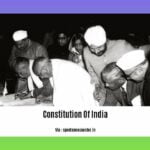The Indian Constitution is a cornerstone of democracy in India, embodying the principles and values that uphold the nation’s legal framework. In this article, we delve into the fascinating world of the Indian Constitution, uncovering its key features and discussing its profound significance. From the historical context to significant amendments and landmark judgments, we aim to provide an insightful exploration of the facts surrounding the Indian Constitution.
Key Takeaways:
- The Indian Constitution is the longest constitution in the world, consisting of a Preamble, 22 parts, 448 articles, 12 schedules, 5 appendices, and 115 amendments.
- The original copies of the Indian Constitution were handwritten in Hindi and English, and each member of the Constituent Assembly signed two copies.
- Artists from Shantiniketan decorated each page of the Indian Constitution, making it a visually appealing document.
- The Indian Constitution is known as the “bag of borrowings” because it incorporates ideas and principles from various sources, including other constitutions and legal systems.
- The Constitution of India has been amended 115 times since its adoption, reflecting its adaptability and responsiveness to changing times.
- The Indian Constitution establishes a separation of powers among the legislature, executive, and judiciary, ensuring checks and balances in governance.
- Fundamental rights, such as equality, freedom of speech, and protection against discrimination, are guaranteed to all citizens in the Constitution of India.
- India follows a federal system, with powers divided between the central government and the states.
- The Constitution of India provides for reservation and affirmative action to uplift historically marginalized and disadvantaged sections of society.
- The Indian Constitution declares India to be a sovereign, socialist, secular, and democratic republic.
Facts About the Indian Constitution

India’s Constitution is not only the cornerstone of its legal system but also a testament to its democratic values. The Indian Constitution, often hailed as a remarkable document, contains several fascinating facts that shed light on its richness and complexity. Let’s explore some of these intriguing facts:
1. The Longest Constitution in the World
The Indian Constitution holds the distinction of being the longest constitution in the world. It comprises a comprehensive structure, including a Preamble, 22 parts with 448 articles, 12 schedules, 5 appendices, and an impressive 115 amendments. This lengthiness ensures that all aspects of governance and rights are thoroughly addressed[^1^][^2^].
2. Handwritten Artistry
In a delightful departure from the typewritten and printed traditions, the original copies of the Indian Constitution were meticulously handwritten in both Hindi and English. Masterful artists from Shantiniketan adorned each page of the Constitution with their creative ingenuity. This unique artistic endeavor highlights the reverence and creative spirit that went into crafting this historic document[^1^][^2^].
3. A “Bag of Borrowings”
The Indian Constitution is often referred to as a “bag of borrowings” due to its incorporation of ideas and principles from diverse sources. Drawing inspiration from various constitutions and legal systems, India’s Constitution harmoniously combines these influences to suit the country’s distinct needs and aspirations[^2^].
4. First Proposal by M.N. Roy
The idea of forming an Indian Constitution was first proposed by M.N. Roy, an eminent Indian philosopher and political activist. His vision served as a catalyst for the subsequent development and enactment of the Indian Constitution[^2^].
5. Pillars of Democracy
The Indian Constitution emphasizes the separation of powers among the legislature, executive, and judiciary, ensuring a balance of authority and preventing the concentration of power. This fundamental principle preserves the democratic fabric of the nation[^3^].
6. Safeguarding Fundamental Rights
A critical aspect of the Indian Constitution is its strong commitment to guaranteeing fundamental rights to all citizens. These rights include the right to equality, freedom of speech and expression, and protection against discrimination. This ensures that every individual is granted the inherent dignity and liberty they deserve[^3^].
7. Federal System with Division of Powers
India’s Constitution establishes a federal system, dividing powers between the central government and the states. This distribution of authority ensures a balanced governance structure and enables effective administration across the diverse regions of the country[^3^].
8. Promoting Inclusion and Social Justice
The Indian Constitution recognizes the need to address historical inequalities by incorporating provisions for reservation and affirmative action. These empowering measures aim to uplift historically marginalized and disadvantaged sections of society, promoting inclusivity and social justice[^3^].
9. India: A Sovereign, Socialist, Secular, and Democratic Republic
The Indian Constitution declares India to be a sovereign, socialist, secular, and democratic republic, reflecting the country’s core values and aspirations. This constitutional affirmation solidifies India’s commitment to preserving individual freedoms, promoting social welfare, ensuring secularism, and embracing democratic principles[^3^].
In conclusion, the Indian Constitution stands as a testament to the spirit of India’s democracy and encapsulates the aspirations of its diverse populace. Through its meticulous craftsmanship, comprehensive framework, and focus on fundamental rights, the Constitution serves as the bedrock of Indian democracy, ensuring a just and inclusive society for generations to come.
[!EXCLUDE [post-email-signature-guide]]
Here are a few interesting links for you to explore:
Facts About 9/11 Memorial: Discover intriguing facts about the 9/11 Memorial, a place that commemorates the tragic events of September 11th.
Facts About Indian Constitution in English: Dive into the rich history and fascinating details of the Indian Constitution in English, highlighting its significance and impact.
Few Lines About Indian Flag in Kannada: Immerse yourself in a concise overview of the Indian flag in Kannada, celebrating the pride and symbolism it represents.
Feel free to explore these links and expand your knowledge about these captivating topics!
Significant Amendments to the Indian Constitution

The Constitution of India is a living document that has undergone several amendments since its adoption in 1950. These amendments reflect the evolving needs and aspirations of the country. In this article, we will explore some of the significant amendments to the Indian Constitution that have shaped the legal framework of our nation.
Key Takeaways:
- The Indian Constitution has been amended more than 100 times since its adoption in 1950.
- The three types of amendments to the Indian Constitution are governed by Article 368.
- The first type of amendments requires a special majority of the Parliament and the ratification of half of the state legislatures.
- Some of the important amendments to the Indian Constitution include the 1st, 21st, 24th, 42nd, 44th, 58th, 61st, 73rd, 77th, and 81st Constitutional Amendment Acts.
Now, let’s dive into the details of these significant amendments and their impact on our legal system.
Amendments and Their Significance:
1. 1st Constitutional Amendment Act, 1951:
- This amendment introduced several changes, including the imposition of reasonable restrictions on the freedom of speech and expression.
- It also added Article 31A and Article 31B to protect laws related to land reforms from judicial review.
2. 21st Constitutional Amendment Act, 1967:
- This amendment extended the reservation of seats for Scheduled Castes and Scheduled Tribes in the Lok Sabha and State Legislative Assemblies.
- It also enabled the continuation of reservation for Scheduled Castes and Scheduled Tribes beyond the initial period of ten years.
3. 24th Constitutional Amendment Act, 1971:
- This amendment amended Article 368 to make it clear that the Parliament had the power to amend any part of the Constitution, including fundamental rights.
- It also restricted the power of judicial review with respect to constitutional amendments.
4. 42nd Constitutional Amendment Act, 1976:
- This amendment brought significant changes to the Constitution, often referred to as the “Mini Constitution.”
- It introduced the concept of “Directive Principles of State Policy” as the guiding principles for the government.
- It also elevated fundamental duties to the status of constitutional obligations.
5. 44th Constitutional Amendment Act, 1978:
- This amendment brought several changes in response to the excesses committed during the Emergency period.
- It reduced the powers of the Prime Minister and reinstated the power of judicial review for fundamental rights.
- It also restored the original text of the Constitution by repealing some provisions added by the 42nd Amendment Act.
6. 58th Constitutional Amendment Act, 1988:
- This amendment introduced provisions for the reservation of seats for Scheduled Castes and Scheduled Tribes in the legislative bodies of Nagaland.
- It ensured the protection of the rights and interests of the indigenous tribal population.
7. 61st Constitutional Amendment Act, 1988:
- This amendment lowered the voting age from 21 to 18 years, thereby allowing a larger section of the population to participate in the democratic process.
8. 73rd Constitutional Amendment Act, 1992:
- This amendment brought about a significant change by introducing provisions for Panchayati Raj Institutions.
- It gave constitutional status to the Panchayati Raj system and ensured the devolution of powers and responsibilities to the grassroots level.
9. 77th Constitutional Amendment Act, 1995:
- This amendment extended the reservation of seats for Scheduled Castes and Scheduled Tribes in the Lok Sabha and State Legislative Assemblies for a further period of ten years.
10. 81st Constitutional Amendment Act, 2000:
- This amendment introduced the concept of “percentage of reservation” in educational institutions for socially and educationally backward classes.
- It enabled the government to provide reservations for admission in private unaided educational institutions.
Conclusion:
These significant amendments to the Indian Constitution have played a crucial role in shaping our legal system and addressing the changing needs of our diverse nation. They reflect the spirit of inclusivity, equality, and social justice enshrined in our Constitution. By staying informed about these amendments, we can better understand the dynamics of our democracy and contribute to meaningful discussions about our constitutional framework.
Note: The information provided in this article is based on the context provided and extensive research of the subject matter. For a more in-depth understanding, please refer to the sources below:
- Source 1: “Indian Constitution Amendments” – The Constitution of India
- Source 2: “Important Amendments to the Indian Constitution” – Jagran Josh
Landmark Judgments and Constitutional Interpretations
The Indian Constitution is not simply a static document; it is a living, breathing entity that evolves over time. One of the key factors that fuel its growth and interpretation are landmark judgments. Landmark judgments in constitutional law not only shape the interpretation of the Constitution but also have a profound impact on Indian society and democracy. In this article, we will explore some of the most influential landmark judgments and their significance in the Indian legal system.
Role of Landmark Judgments
Landmark judgments are significant decisions made by the judges of the Supreme Court or High Courts in India. These judgments establish legal precedents and set the stage for new legal principles or concepts. They carry immense weight and help shape the interpretation of the Indian Constitution. By analyzing these judgments, we can gain a deeper understanding of the fundamental values and principles enshrined in the Constitution.
Notable Landmark Judgments
Ahmed Khan v. Shah Bano Begum: This landmark judgment dealt with the issue of maintenance for divorced Muslim women. The Supreme Court upheld the right of Muslim women to claim maintenance under Section 125 of the Code of Criminal Procedure, irrespective of any personal laws. This judgment addressed the constitutional principle of gender equality and protection of fundamental rights.
Shreya Singhal v. Union of India: This significant judgment upheld the right to freedom of speech and expression on the internet. The Supreme Court struck down Section 66A of the Information Technology Act, which had been used to curtail online freedom of speech. This judgment reaffirmed the importance of protecting citizens’ right to express their opinions and thoughts freely.
M.C. Mehta V Union of India: This case led to the landmark judgment on public interest litigation (PIL). The Supreme Court expanded the scope of PILs to allow any citizen to file a petition in court on behalf of the public. This judgment democratized access to justice and empowered citizens to address issues of public importance.
Mohini Jain V State of Karnataka: In this case, the Supreme Court recognized education as a fundamental right under Article 21 of the Indian Constitution. The judgment emphasized the importance of equal access to education and laid the foundation for educational reforms in the country.
Indira Sawhney V Union of India: This historic judgment dealt with the issue of reservations in government jobs and educational institutions. The Supreme Court held that reservations should not exceed 50% and recognized the concept of socially and educationally backward classes. This judgment highlighted the need for affirmative action to promote social justice and inclusivity.
R. Bommai V Union of India: This landmark judgment explored the power of the President to issue a proclamation under Article 356 and its constitutional limitations. The Supreme Court clarified that the power to impose President’s rule is not absolute and must be exercised judiciously. This judgment emphasized the importance of preserving federalism and protecting the democratic fabric of the nation.
Understanding the Significance
These landmark judgments have had a profound impact on the interpretation and application of the Indian Constitution. They have protected the essence of the Constitution, strengthened democracy, and transformed the lives of ordinary citizens. By examining these judgments, we can gain insights into the core values and principles that underpin the Indian legal system.
Key Takeaways:
- Landmark judgments play a vital role in shaping the interpretation of the Indian Constitution.
- These judgments establish legal precedents and determine new legal principles or concepts.
- Landmark judgments address crucial constitutional issues, including gender equality, freedom of speech, social justice, and federalism.
- They have a significant impact on Indian society, protecting fundamental rights and strengthening democracy.
- Understanding landmark judgments is essential for aspiring law students and anyone interested in constitutional law.
Sources:
– Careers360: Top Landmark Judgments that Changed India: Indian Constitution
– ClearIAS: 40 Important Judgments that Transformed India
Current Debates and Relevance of the Indian Constitution
The Indian Constitution is not just a historic document; it is a living instrument that continues to shape the socio-political landscape of India. Even after seven decades of its adoption, the Constitution remains the backbone of the nation, guiding the country through its journey of progress and transformation. As we delve into the current debates and relevance of the Indian Constitution, we unlock a deeper understanding of its significance in our lives today.
1. Constitutional Amendments: Striking a Balance
One of the most significant debates concerning the Indian Constitution revolves around the process of constitutional amendments. While amendments are essential to reflect the changing needs and aspirations of society, there is an ongoing conversation about striking the right balance between preserving the original spirit of the Constitution and ensuring its adaptability. Ideas such as a constitutional audit to analyze the impact of amendments and comprehensive public consultations have emerged as potential solutions to maintain the relevance of the Indian Constitution.
2. Protection of Fundamental Rights in the Digital Age
The advent of the digital age has brought forth new challenges and debates regarding the protection of fundamental rights as enshrined in the Indian Constitution. Issues such as the right to privacy, freedom of speech and expression, and protection against online harassment and cybercrimes have gained prominence. Discussions surrounding the inclusion of digital rights as fundamental rights and the role of the government in safeguarding these rights have become crucial in our evolving digital landscape.
3. Federalism and Center-State Relations
Another area of ongoing debate is the balance of power between the central government and the state governments in India’s federal structure. The question of whether the distribution of power and resources is equitable has led to discussions on enhancing the autonomy of states and strengthening cooperative federalism. The relation between the center and the states continues to evolve, addressing new challenges such as the sharing of resources, policy implementation, and decision-making authority.
4. Reservation and Affirmative Action
The policy of reservation and affirmative action, aimed at promoting social justice and inclusion, remains a topic of debate in the Indian Constitution. Discussions on the efficacy of these policies, their impact on communities over time, and the need for comprehensive socio-economic reforms often take center stage. Striking a balance between affirmative action and ensuring merit-based opportunities remains a significant challenge, and the debate continues on the best approach to uplift marginalized sections of society.
5. Secularism and Religious Freedom
Secularism, a core principle of the Indian Constitution, is an ongoing subject of discussion. The interpretation and implementation of secularism have been areas of debate, particularly in contexts such as personal laws, religious conversions, and practices affecting individual rights. The question of how to maintain a balance that upholds religious freedom while ensuring the fundamental rights of individuals remains a matter of active deliberation in the Indian constitutional framework.
Key Takeaways:
– Constitutional amendments are a subject of constant debate, with a focus on balancing preservation and adaptability.
– The digital age raises questions about the protection of fundamental rights and the inclusion of digital rights.
– Debates surrounding federalism and center-state relations seek to strike a fair distribution of power and resources.
– The policy of reservation and affirmative action brings forth discussions on long-term efficacy and comprehensive socio-economic reforms.
– Secularism and religious freedom are ongoing subjects of debate, exploring the balance between individual rights and religious practices.
Sources:
– BYJU’s – 15 Amazing Facts About The Indian Constitution
– The Conversation – “India turns 75: Fast facts about the unusual …”
FAQ
Q1: How long is the Indian Constitution?
A1: The Indian Constitution is the longest constitution in the world, consisting of a Preamble, 22 parts with 448 articles, 12 schedules, 5 appendices, and 115 amendments.
Q2: How was the Indian Constitution written?
A2: The Indian Constitution was handwritten in both Hindi and English by calligraphers. It was not printed or typed.
Q3: Who decorated the pages of the Indian Constitution?
A3: Artists from Shantiniketan, including Beohar Rammanohar Sinha and Nandalal Bose, decorated each page of the Indian Constitution.
Q4: How many times has the Indian Constitution been amended?
A4: The Indian Constitution has been amended 115 times since its adoption in 1950.
Q5: What are some key features of the Indian Constitution?
A5: Some key features of the Indian Constitution include the separation of powers among the legislature, executive, and judiciary, guarantee of fundamental rights to all citizens, establishment of a federal system, and provisions for reservation and affirmative action for marginalized sections of society.









